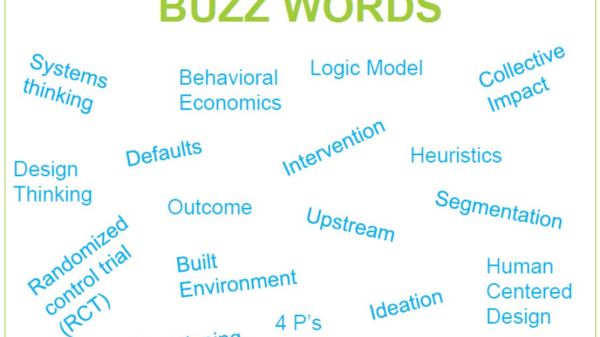Social and Behavior Change Buzz Words

Last year the Social Marketing Association of North America (https://smana.org/) collaborated with the Partnership for Food Safety Education (https://www.fightbac.org) to conduct a webinar series https://youtu.be/gDOUH4JTHKY) that reviewed three main social and behavior change disciplines – social marketing, design thinking or human-centered design, behavioral economics. I conducted the social marketing webinar and two other colleagues discussed design thinking and behavioral economics. The final webinar was a panel discussion talking about the strengths, weaknesses and commonalities of each methodology. We learned there is no silver bullet but there are lots of similarities.
Regarding the history of each of these strategies: Social marketing started in the 1970’s; design thinking is relatively new (2000’s) out of the Stanford Design School; and behavioral economics, although it had a seminal article in the late 1970’s, really gained attention in 2002 when it’s founder won a Nobel prize. Social marketing started by promoting family planning in developing countries; design thinking began with computer interfaces (like computer mice, tablets, apps and websites); and behavioral economics started with economic decisions like retirement planning.
Design thinking often focuses on “wicked” ill-defined problems and behavioral economics has traditionally focused on well-defined behaviors. As a social marketer, I think it straddles both areas. I believe social marketers would say they are rooted in theory; design thinkers are based in ideation; and behavioral economics relies heavily on the literature to guide them.
When it comes to thinking about the audience and their behavior, social marketing, (since it is rooted in traditional marketing) believes in providing a value proposition where the pros and cons are weighed against each other. Design thinkers work to empathize with their audience and finally, behavioral economists believe people are irrational and emotional in their behavior choice. There is no right or wrong component here but just be aware of the different options you may have based on your audience.
Each of the disciplines is rooted in audience research, however, social marketers may use qualitative and quantitative mixed methods research; design thinkers mostly use qualitative methods like interviews and journey mapping; whereas behavioral economics is heavily rooted in quantitative surveys, observations and randomized control trials. These distinct research lines are beginning to blur as the different disciplines learn from each other and collaborate.
Each discipline has a set of steps they follow, and all are iterative, so you test, learn, test again. What is important to point out is that each group has their own set of “jargon” but when it comes down to the meaning of the words there are lots of similarities. For example:
Each one has a term for working with an audience. Social marketing says “segmentation”, design thinking creates “personas” and behavioral economics does “behavioral diagnosis”.
- In social marketing, we say “prompt” and in behavioral economics, they use “nudge”.
- In social marketing we might use the term “behavioral chain” but in behavioral economics, they say “behavioral mapping”. Both represent a group of behaviors that need to happen together to get to your ultimate desired outcome.
- Prior to implementing a campaign fully, social marketers “pilot”, design thinkers “prototype” and behavioral economists “test”.
In summary, I highlighted three social and behavior change disciplines which thankfully have a lot in common.
- All are rooted in psychology.
- Each believes that knowledge and awareness alone does not change behavior.
- All three know research is key to understanding your audience and getting to impact.
- It is important to test/pilot/prototype (pick your favorite word) the message campaign and/or intervention.
- Each has an iterative process that includes monitoring.
- All believe campaigns should have measurement and evaluation to assure impact.
What do you think? Do you agree with these similarities across disciplines?
